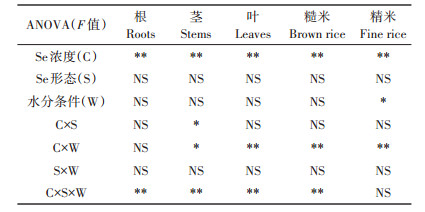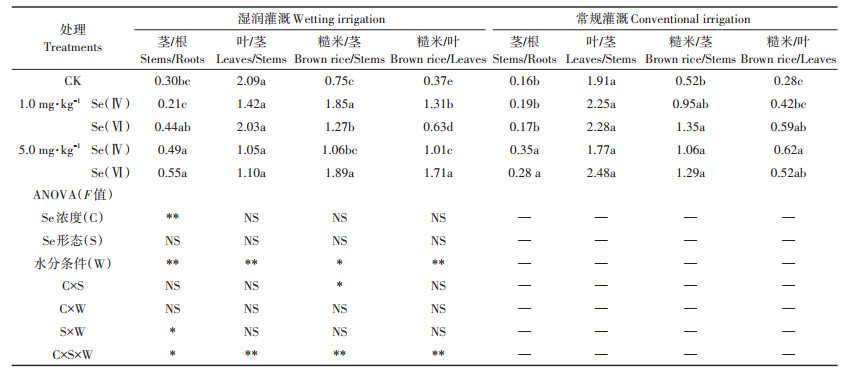2. 农业农村部产地环境污染防控重点实验室, 天津 300191;
3. 福建农林大学, 福州 350002
2. Key Laboratory of AgroEnvironmental Pollution Control and Prevention, Ministry of Agriculture and Rural Affairs, Tianjin 300191, China;
3. Fujian Agriculture and Forestry University, Fuzhou 350002, China
硒(Se)在生物体中, 具有抗氧化、保护细胞免受损伤的功能, 是人体必需微量元素[1-2]。我国约72%的土壤面积属缺Se或低Se状态[3], 全国人均日Se摄入量只有中国营养学会推荐下限值的一半左右[4]。水稻作为我国主粮, 通过施加Se肥、增加稻米Se含量, 是改善缺Se状态的有效途径。
Se在土壤中主要以硒化物(-2价)、元素硒(0价)、亚硒酸盐(+4价)、硒酸盐(+6价)及有机复合物存在。植物对土壤硒的利用率较低, 主要吸收水溶性的硒酸盐、亚硒酸盐和部分有机硒, 其中硒酸盐的有效性最高[5-7]。土壤氧化还原电位是影响Se形态和生物有效性的主要因素之一, 土壤氧化性越强, 植物对Se的利用率越高[8]。研究表明, 湿润灌溉是提高水稻Se含量最有效方法之一[3], 原因可能在于湿润灌溉下, 亚硒酸盐氧化为硒酸盐, 硒酸盐与土壤固相结合能力低, 更容易被植物所利用[9-10];而亚硒酸盐易与铁形成水溶性极低的氧化物和水合氧化物, 不易被植物吸收利用[11-12]。另有报道显示[13], 添加硒酸盐或亚硒酸盐时, 湿润灌溉下籽粒Se含量比淹水灌溉下高, 但不添加Se时, 淹水灌溉下更高。
稻田具有特殊的氧化还原交替环境, 势必会对Se的有效性产生影响。而且, 淹水还原条件下还会改变pH值趋向于中性, 而pH值也是影响Se形态和有效性的因素之一[8]。因此, 不同水分条件可能会显著影响水稻对Se的吸收, 迄今相关研究较少。本文主要研究在淹水和非淹水湿润条件下, 施加不同形态和浓度的Se对水稻Se吸收与转运的影响, 为提高稻米Se含量提供理论和技术支撑。
1 材料与方法 1.1 试验材料供试水稻为上海市农业生物基因中心提供的对干旱胁迫有较强耐性的常规品种SINALOAA68。供试土壤采自湖南郴州某污染稻田(0~20 cm), 基本理化性状如下:pH 6.65、阳离子交换量12.5 cmol·L-1、有机质24.3 g·kg-1、碱解氮33.56 mg·kg-1、速效磷20.37 mg·kg-1、速效钾34.29 mg·kg-1、全Se含量0.65 mg· kg-1。供试土壤经自然风干后磨碎过5 mm筛, 充分混匀后备用。
1.2 试验设计采用盆栽试验, 每盆装土5 kg, 与基肥[N:P2O5: K2O=1:1:1(质量比)]反复混匀。水分条件设两种处理:湿润灌溉(保持35%田间持水量)、常规灌溉(长期淹水保持水层2 cm以上, 仅在分蘖后期和收获前分别落干一周)。试验以不施硒肥为对照(CK), Se处理包括Na2SeO3 [Se (Ⅳ)]和Na2SeO4 [Se (Ⅵ)], 分别设置2个浓度水平, 分别为:1.0 mg·kg-1和5.0 mg·kg-1。硒处理浓度均在水稻安全范围以内, 并未危害水稻生长。试验采用完全正交设计, 共10个处理, 每处理4次重复。
水稻成熟后收样, 按不同组织(根、茎、叶、稻谷)分离, 用自来水洗净表面, 最后用去离子水润洗, 用滤纸吸干表面水分, 将洗净后的根、茎、叶于105 ℃杀青30 min, 75 ℃烘干至恒质量, 稻谷风干脱粒后分为糙米和精米, 留待测用。
水稻样品用硝酸-高氯酸(4:1)混合消煮, Se含量用ICP-MS(Agilent 7900x, USA)测定, 使用国家标准物质大米粉(GBW 10010)进行质量控制, 回收率在90%~110%之间, 测定结果全部在定值范围内。
1.3 数据分析使用Microsoft Excel 2013及SPSS 20.0软件进行数据及多因素方差分析处理, 用LSD方法比较平均值(P < 0.05)。
2 结果与分析 2.1 不同水分条件下Se对秸秆干质量和籽粒重量的影响水分条件对水稻生长影响显著(表 1), 相比湿润灌溉, 常规灌溉显著增加秸秆干质量及籽粒产量, 增幅分别为1.26~1.69倍及0.94~1.53倍。施Se会显著促进水稻生长。与CK相比, Se处理后在湿润灌溉下, 秸秆干质量和籽粒产量增幅分别为22.35%~ 39.76%和35.42%~61.94%, 在常规灌溉下增幅分别为19.18%~57.23%和4.02%%~55.37%。
|
|
表 1 不同水分条件下施Se对水稻生长的影响 Table 1 The effect of Se on rice growth under different water managements |
Se浓度、Se形态及水分条件之间对秸秆干质量无交互作用, 对籽粒产量影响存在交互作用(P < 0.05)。Se浓度、水分条件对秸秆干质量存在交互作用, 最高生物量为常规灌溉下施1.0 mg·kg-1 Se。常规灌溉下, 施1.0 mg·kg-1 Se (Ⅳ)或Se (Ⅵ)可得到高秸秆干质量, 施1.0 mg·kg-1 Se(Ⅳ)或5.0 mg·kg-1 Se(Ⅵ)可得到高籽粒产量。
2.2 不同水分条件下水稻各部位Se含量施Se显著促进水稻Se吸收, 各部位Se含量随Se处理浓度的升高而显著升高(图 1~图 5)。湿润与常规灌溉下, 1.0 mg·kg-1 Se(Ⅳ)处理, 根部Se含量分别是CK的3.69倍和2.12倍, 茎Se含量分别是CK的2.71倍和2.51倍, 叶Se含量分别是CK的1.95倍和2.97倍, 糙米Se含量分别是CK的6.94倍和4.53倍, 精米Se含量是CK的6.86倍和5.29倍。5.0 mg·kg-1 Se (Ⅳ)处理, 根部Se含量分别是CK的12.05倍和5.56倍, 茎Se含量分别是CK的20.33倍和11.70倍, 叶Se含量分别是CK的10.76倍和10.94倍, 糙米Se含量分别是CK的29.72倍和23.69倍, 精米Se含量是CK的31.61倍和23.37倍。水稻对低、高浓度的Se (Ⅵ)吸收与Se (Ⅳ)相似。
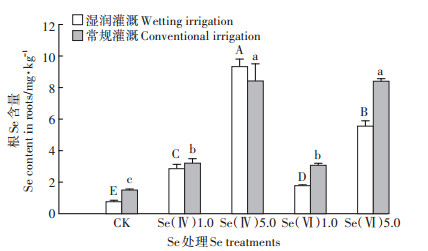
|
不同字母表示差异显著(P < 0.05),大写、小写字母分别表示湿润灌溉和常规灌溉下的差异性。下同 Values followed by different letters are significantly different at P < 0.05. Uppercase and lowercase letters represent differences between wet irrigation and conventional irrigation, respectively. The same below 图 1 不同水分条件下施Se对水稻根Se含量的影响 Figure 1 Effects of Se on the content of Se in roots under different water managements |
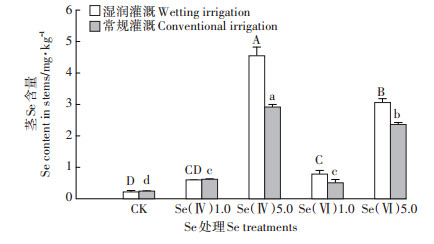
|
图 2 不同水分条件下施Se对水稻茎Se含量的影响 Figure 2 Effects of Se on the content of Se in stems under different water managements |
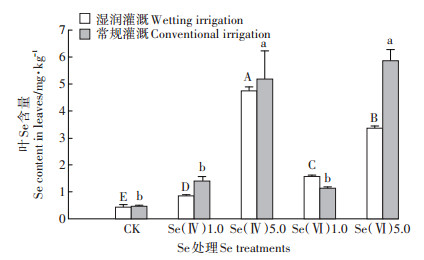
|
图 3 不同水分条件下施Se对水稻叶Se含量的影响 Figure 3 Effects of Se on the content of Se in leaves under different water managements |
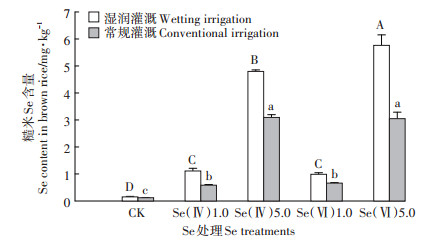
|
图 4 不同水分条件下施Se对水稻糙米Se含量的影响 Figure 4 Effects of Se on the content of Se in brown rice under different water managements |
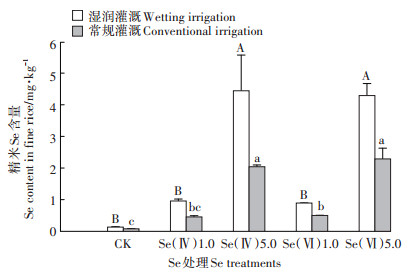
|
图 5 不同水分条件下施Se对水稻精米Se含量的影响 Figure 5 Effects of Se on the content of Se in fine rice under different water managements |
Se浓度、Se形态及水分条件3因素对水稻根、茎、叶、糙米Se含量存在显著的交互作用(P < 0.05)(表 2)。根系Se含量, 在湿润灌溉下, Se(Ⅳ)的吸收显著超过Se(Ⅵ), 后者根系浓度在低、高浓度处理下, 分别是前者的62.5%和59.6%;常规灌溉下, 不同形态间无显著差别。茎部Se含量, 在高浓度处理下, 湿润灌溉显著高于常规灌溉, 而且Se(Ⅳ)的吸收显著高于Se(Ⅵ), 前者在湿润与常规灌溉下分别为4.55 mg· kg-1和2.92 mg·kg-1, 后者分别为3.07 mg·kg-1和2.37 mg·kg-1。叶Se含量, Se浓度和水分条件存在交互作用(P < 0.05), 最大吸收量为常规灌溉下施5.0 mg·kg-1 Se。糙米和精米Se含量, Se形态间不存在差异, 但湿润灌溉下的含量均显著高于同浓度下的常规灌溉处理。
|
|
表 2 Se浓度、Se形态及水分条件3因素对水稻各部位Se含量的方差分析 Table 2 Analysis of variance of Se content in different parts of rice by three factors |
水分条件显著影响影响水稻Se转运(表 3)。相比常规灌溉, 湿润灌溉显著增加水稻Se茎/根、糙米/茎、糙米/叶转运系数, 增幅分别为40.00%~158.82%、44.23%~94.73%及6.78%~228.85%, 但显著降低Se叶/茎转运系数。
|
|
表 3 不同水分条件下施Se对水稻Se转运系数的影响 Table 3 Effects of Se on the Se transfer coefficients in rice plant under different water managements |
施Se对水稻Se转运影响如表 3所示。与CK处理相比, Se茎/根转运系数在高浓度处理下显著增加, 5.0 mg·kg-1 Se(Ⅳ)、5.0 mg·kg-1 Se(Ⅵ)处理在湿润与常规灌溉下增幅分别为63.33%、83.33%和118.75%、75.00%。施Se对叶/茎转运系数并无显著影响。湿润与常规灌溉下, 1.0 mg·kg-1 Se(Ⅳ)处理, 糙米/茎转运系数分别是CK的2.47倍和1.83倍, 糙米/叶转运系数分别是CK的3.54倍和1.50倍;5.0 mg·kg-1 Se(Ⅳ)处理, 糙米/茎转运系数分别是CK的1.41倍和2.00倍, 糙米/叶转运系数分别是CK的2.73倍和2.21倍。Se向水稻籽粒转运在低、高浓度的Se(Ⅵ)与Se(Ⅳ)处理下相似。
Se浓度、Se形态及水分条件3因素对水稻Se茎/根、叶/茎、糙米/茎、糙米/叶转运系数存在显著的交互作用(P < 0.05)(表 3)。Se茎/根转运系数, 在湿润灌溉下, Se(Ⅵ)的转运在低浓度下显著超过Se(Ⅳ), 前者是后者的2.09倍, 高浓度下不同形态间无显著差异;常规灌溉下, 不同形态间无显著差别。Se糙米/茎、糙米/叶转运系数, 在湿润灌溉下, 低浓度的Se (Ⅳ)处理显著高于高浓度, 后者分别是前者的57.30%和77.10%, 而低浓度的Se(Ⅵ)处理显著低于高浓度, 前者分别是后者的67.20%和36.84%。
3 讨论水稻各部位Se含量与其吸收能力有关。当不施Se时, 各部位Se含量的大小顺序为根>叶>茎>糙米>精米, Se容易在茎叶中富集, 这与文献报道基本一致[14-16]。Se被水稻根部吸收, 然后转运至茎和叶中, 最后由叶分配至籽粒中[17]。当向土壤施Se时, 在常规灌溉下各部位Se含量大小顺序与不施Se一致, 前人也发现类似结果[16]。但也有研究发现[14, 18], 施Se时, 水稻各部位Se含量大小顺序为根>籽粒>叶>茎, Se容易向籽粒富集。而在湿润灌溉下, 施高浓度Se时, 水稻各部位Se含量大小顺序为根>籽粒>叶>茎, 而施低浓度Se(Ⅵ)时, 趋势为根>叶>籽粒>茎。因此, 不同水分条件下水稻各部位Se吸收能力值得深入研究。
不同水分条件在一定程度上影响水稻生长、Se吸收及转运。水分条件通过影响土壤溶液的pH与Eh, 进而影响土壤中的Se形态。常规灌溉下, 土壤大部分处于淹水状态, 还原态环境中Se形态主要为元素Se和硒化物。湿润灌溉下, 硒酸盐及亚硒酸盐是土壤中主要的硒形态。Li等[13]研究发现, 在不施Se情况下, 淹水状态中水稻秸秆Se含量高于湿润灌溉, 与本研究结果一致, 即常规灌溉下水稻茎、叶Se含量高于湿润灌溉。有研究发现, 施Se时相比淹水灌溉, 湿润灌溉下会得到高水稻籽粒产量[19], 与本研究施Se时的结果相反。Zhou等[3]研究发现, 湿润灌溉下施Se会使秸秆及籽粒Se含量都显著高于淹水灌溉。本研究发现, 水分条件对水稻各部位(除精米外) Se吸收并无显著差异, 但会显著影响Se转运系数。相比常规灌溉, 湿润灌溉下施Se会显著增加Se茎/根、糙米/茎、糙米/叶转运系数, 可能是由于湿润灌溉下, Se(Ⅳ)氧化为Se(Ⅵ), Se(Ⅵ)与土壤固相结合能力低, 有较强的移动性, 容易从根部转移到植物地上部[9]。
施Se会显著促进植物生长及各部位Se吸收, 与以前文献报道[17, 20]类似。硒酸盐、亚硒酸盐可分别通过硫酸盐、磷酸盐通道被植物吸收[21]。由于亚硒酸盐容易吸附在土壤矿物上, 因此相比硒酸盐, 亚硒酸盐的生物可利用性较低[11]。另外, 硒酸盐很容易从根部转运到茎叶中, 而亚硒酸盐从根部向地上部的转运能力较低[9]。本研究发现, Se形态对水稻生长无显著影响。Boldrin等[22]也有类似研究结果, 施Se(Ⅳ)、Se(Ⅵ)对水稻籽粒产量无显著差异。叶面喷施Se (Ⅳ)、Se (Ⅵ)对马铃薯块茎产量影响也有类似研究结果[23]。研究发现, 植物吸收与转运Se(Ⅳ)、Se(Ⅵ)的能力也无显著差异。Li等[24]在蓝莓中也有类似发现, 施Se(Ⅳ)、Se(Ⅵ)对蓝莓各部位Se吸收无显著差异。然而, 也有研究发现, 相比Se(Ⅳ), 施Se(Ⅵ)会显著增加水稻籽粒[22]、黑麦草茎叶[11]Se含量。Longchamp等[25]在玉米中发现相反结果, 相比Se(Ⅵ), 施Se(Ⅳ)会显著增加玉米粒Se含量。这些结果表明, 植物吸收、转运Se机理值得深入研究讨论。
4 结论(1) 施Se显著促进水稻生长、Se吸收与转运。
(2) Se浓度、Se形态及水分条件之间对水稻生长、Se吸收及转运存在显著的交互作用(P < 0.05)。
(3) 常规灌溉与湿润灌溉相比, 显著增加籽粒产量、秸秆干质量及Se叶/茎转运系数。后者较前者, 显著增加茎/根、糙米/茎、糙米/叶Se转运系数。湿润灌溉较常规灌溉, 更有利于Se向籽粒转运。
| [1] |
Brown K M, Arthur J R. Selenium, selenoproteins and human health:A review[J]. Public Health Nutrition, 2001, 4(2): 593-599. |
| [2] |
殷行行, 郑向群, 丁永祯, 等. 亚硒酸盐对旱稻吸收、转运砷及其氧化性胁迫的影响研究[J]. 农业环境科学学报, 2017, 36(5): 817-825. YIN Xing-xing, ZHENG Xiang-qun, DING Yong-zhen, et al. Effect of selenite on arsenic uptake, translocation and oxidative stress of upland rice[J]. Journal of Agro-Environment Science, 2017, 36(5): 817-825. |
| [3] |
Zhou X B, Li Y Y, Lai F. Effects of different water management on absorption and accumulation of Se in rice[J]. Saudi Journal of Biological Sciences, 2018, 25(6): 1178-1182. DOI:10.1016/j.sjbs.2017.10.017 |
| [4] |
Xia Y M, Hill K E, Byrne D W, et al. Effectiveness of selenium supplements in a low-selenium area of China[J]. The American Journal of Clinical Nutrition, 2005, 81(4): 829-834. DOI:10.1093/ajcn/81.4.829 |
| [5] |
Li J, Peng Q, Liang D L, et al. Effects of aging on the fraction distribution and bioavailability of Se in three different soil[J]. Chemosphere, 2016, 144: 2351-2359. DOI:10.1016/j.chemosphere.2015.11.011 |
| [6] |
Wang J W, Wang Z H, Mao H, et al. Increasing Se concentration in maize grain with soil- or foliar-applied selenite on the Loess Plateau in China[J]. Field Crops Research, 2013, 150: 83-90. DOI:10.1016/j.fcr.2013.06.010 |
| [7] |
黄太庆, 江泽普, 邢颖, 等. 水稻对外源硒的吸收利用研究[J]. 农业资源与环境学报, 2017, 34(5): 449-455. HUANG Tai-qing, JIANG Ze-pu, XING Ying, et al. Effects of exogenous Se on paddy rice growth, Se uptake and accumulation[J]. Journal of Agricultural Resources and Environment, 2017, 34(5): 449-455. |
| [8] |
王晓芳, 陈思阳, 罗章, 等. 植物对硒的吸收转运和形态转化机制[J]. 农业资源与环境学报, 2014, 31(6): 539-544. WANG Xiao-fang, CHEN Si-yang, LUO Zhang, et al. Mechanisms of selenium uptake, translocation and chemical speciation transformation in plants[J]. Journal of Agricultural Resources and Environment, 2014, 31(6): 539-544. |
| [9] |
Li H F, Mcgrath S P, Zhao F J. Selenium uptake, translocation and speciation in wheat supplied with selenate or selenite[J]. New Phytologist, 2008, 178(1): 92-102. DOI:10.1111/j.1469-8137.2007.02343.x |
| [10] |
Neal R H, Sposito G. Selenate adsorption on alluvial soils[J]. Soil Science Society of America Journal, 1989, 53: 70-74. DOI:10.2136/sssaj1989.03615995005300010013x |
| [11] |
Cartes P, Gianfreda L, Mora M L. Uptake of Se and its antioxidant activity in ryegrass when applied as selenate and selenite forms[J]. Plant and Soil, 2005, 276(1): 359-367. |
| [12] |
Gabos M B, Goldberg S, Alleoniand L R. Modeling selenium(Ⅳ and Ⅵ)adsorption envelopes in selected tropical soils using the constant capacitance model[J]. Environmental Toxicology and Chemistry, 2014, 33(10): 2197-2207. DOI:10.1002/etc.2574 |
| [13] |
Li H F, Lombi E, Stroud J L, et al. Selenium speciation in soil and rice:Influence of water management and Se fertilization[J]. Journal of Agricultural and Food Chemistry, 2010, 58(22): 11837-11843. DOI:10.1021/jf1026185 |
| [14] |
周鑫斌, 施卫明, 杨林章. 富硒与非富硒水稻品种对硒的吸收分配的差异及机理[J]. 土壤, 2007, 39(5): 731-736. ZHOU Xin-bin, SHI Wei-ming, YANG Lin-zhang. Genotypical differences and characteristics of Se uptake and accumulation in rice[J]. Soils, 2007, 39(5): 731-736. DOI:10.3321/j.issn:0253-9829.2007.05.010 |
| [15] |
陈雪, 沈方科, 梁欢婷, 等. 外源施硒措施对水稻产量品质及植株硒分布的影响[J]. 南方农业学报, 2017, 48(1): 46-50. CHEN Xue, SHEN Fang-ke, LIANG Huan-ting, et al. Effects of exogenous selenium application on rice yield, quality, distribution of selenium in seedling[J]. Journal of Southern Agriculture, 2017, 48(1): 46-50. |
| [16] |
钟松臻, 张木, 张宝军, 等. 硒高/低累积型水稻富硒特征的比较研究[J]. 土壤通报, 2017, 48(4): 943-947. ZHONG Song-zhen, ZHANG Mu, ZHANG Bao-jun, et al. Comparison on characteristics of selenium accumulation in high- and low- selenium rice cultivars[J]. Chinese Journal of Soil Science, 2017, 48(4): 943-947. |
| [17] |
Kikkert J, Hale B, Berkelaar E. Selenium accumulation in durum wheat and spring canola as a function of amending soils with selenite, selenate and or sulphate[J]. Plant and Soil, 2013, 372(1): 629-641. |
| [18] |
陈雪, 沈方科, 张增裕, 等. 硒肥和土壤类型对水稻硒吸收的影响[J]. 西南农业学报, 2017, 30(9): 2010-2016. CHEN Xue, SHEN Fang-ke, ZHANG Zeng-yu, et al. Effects of soil type and selenium application on assimilation of selenium in rice[J]. Southwest China Journal of Agricultural Sciences, 2017, 30(9): 2010-2016. |
| [19] |
Mostafazadeh-Fard B, Jafari F, Mousavi S F. Effects of irrigation water management on yeild and water use efficiency of rice in cracked paddy soils[J]. Australian Journal of Crop Science, 2011, 4(3): 136-141. |
| [20] |
Han D, Li X H, Xiong S L, et al. Selenium uptake, speciation and stressed response of Solanum tuberosum L.[J]. Environmental and Experimental Botany, 2013, 95: 6-14. DOI:10.1016/j.envexpbot.2013.07.001 |
| [21] |
White P J, Broadley M R. Biofortification of crops with seven mineral elements often lacking in human diets:Iron, zinc, copper, calcium, magnesium, selenium and iodine[J]. New Phytologist, 2009, 182(1): 49-84. DOI:10.1111/j.1469-8137.2008.02738.x |
| [22] |
Boldrin P F, Faquin V, Ramos S J, et al. Soil and foliar application of Se in rice biofortification[J]. Journal of Food Composition and Analysis, 2013, 31(2): 238-244. DOI:10.1016/j.jfca.2013.06.002 |
| [23] |
Zhang H Q, Zhao Z Q, Zhang X, et al. Effects of foliar application of selenate and selenite at different growth stages on selenium accumulation and speciation in potato(Solanum tuberosum L.)[J]. Food Chemistry, 2019, 286: 550-556. DOI:10.1016/j.foodchem.2019.01.185 |
| [24] |
Li M F, Zhao Z Q, Zhou J J, et al. Effects of a foliar spray of selenite or selenate at different growth stages on selenium distribution and quality of blueberries[J]. Journal of the Science of Food and Agriculture, 2018, 98(12): 4700-4706. DOI:10.1002/jsfa.9004 |
| [25] |
Longchamp M, Castrec-Rouelle M, Biron P, et al. Variations in the accumulation, localization and rate of metabolization of selenium in mature Zea mays plants supplied with selenite or selenate[J]. Food Chemistry, 2015, 182: 128-135. DOI:10.1016/j.foodchem.2015.02.137 |
 2019, Vol. 38
2019, Vol. 38




